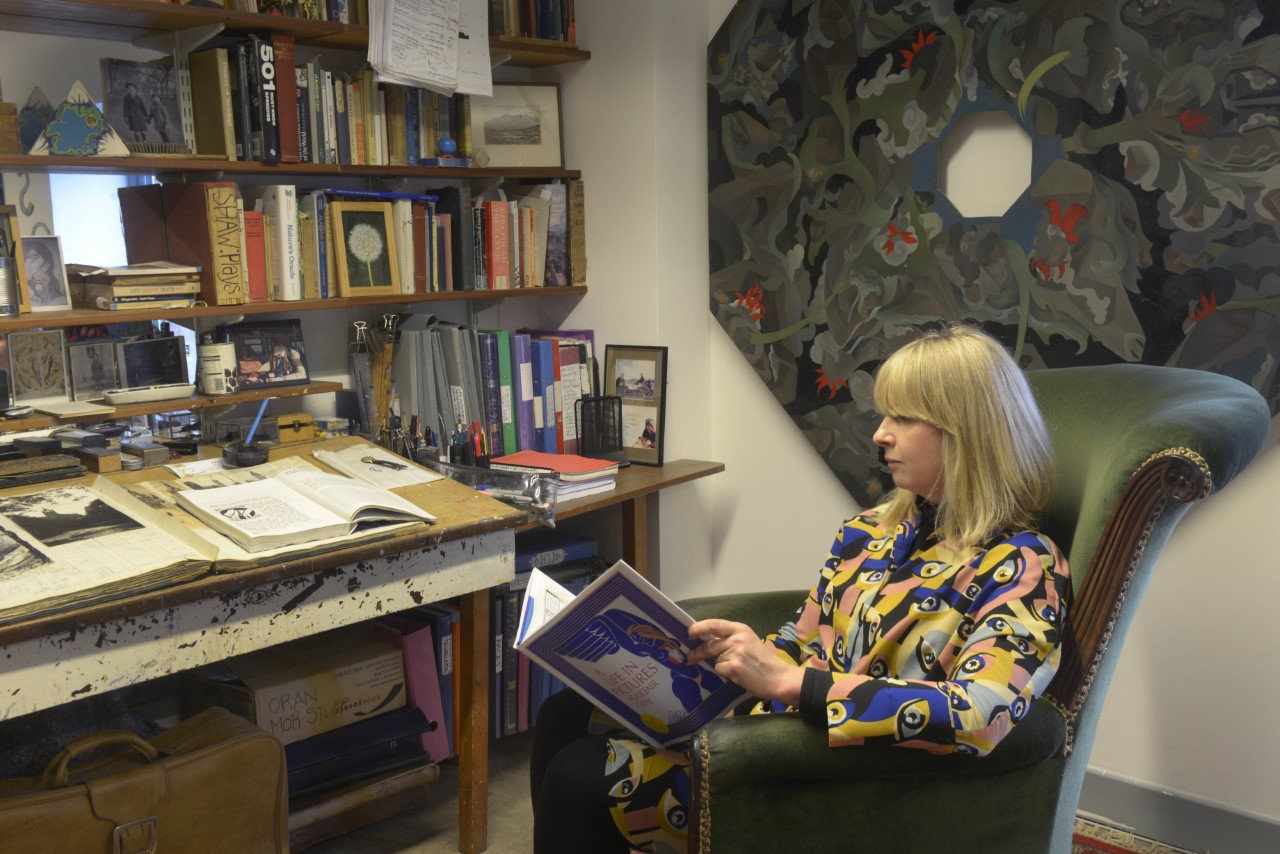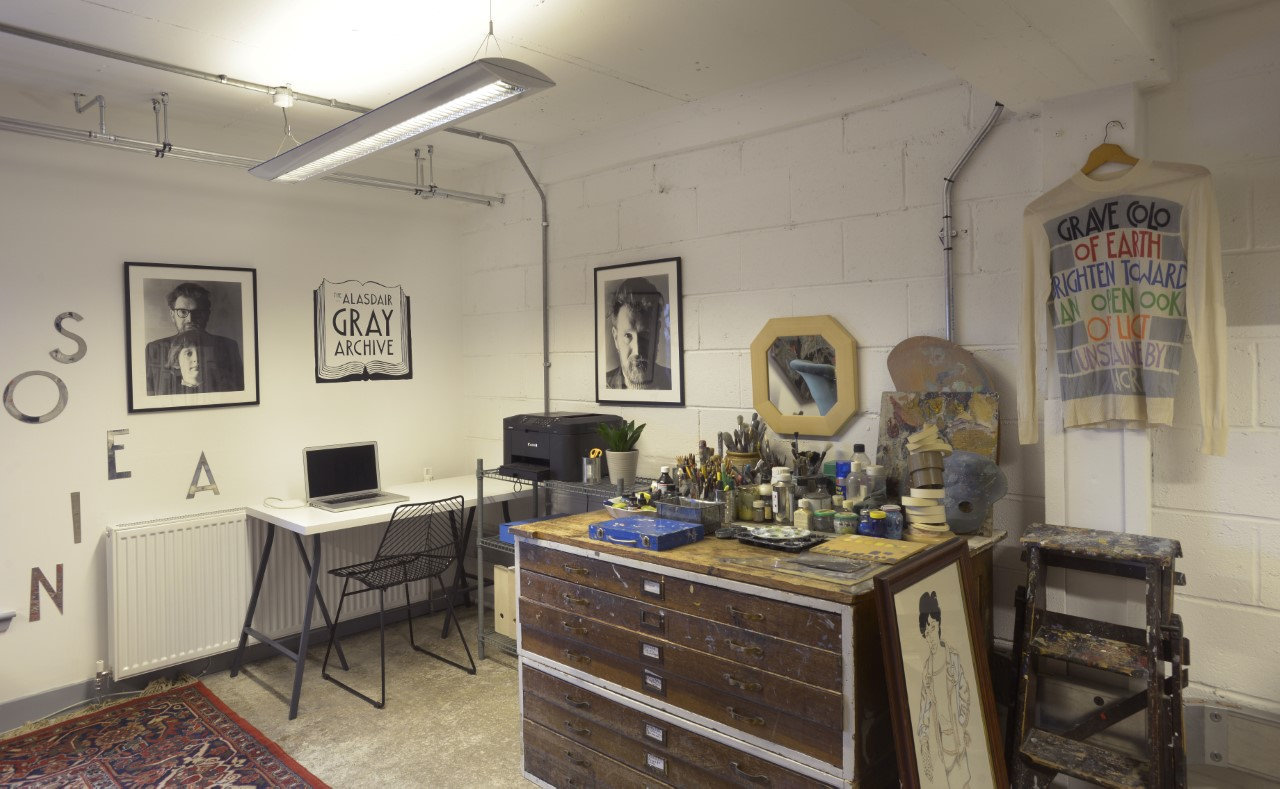
PROFESSOR Alan Riach in conversation with Sorcha Dallas, custodian of the Alasdair Gray Archive
Alan Riach: Alasdair Gray’s writing seems to me to be permeated by a visual sensibility in a particular way. He talks about seeing, what’s to be seen, how seeing happens and what seeing things brings to the mind, how it enhances understanding. Questions of perspective, the multiplicity of vision, the idea of people as a plurality of possibilities, as living potential. It’s never as if there is only one way of seeing, one dominant perspective. Does that chime with your sense of his legacy and what is collected in the Alasdair Gray Archive?
Sorcha Dallas: Absolutely. The Archive is about sharing the story of Alasdair’s life but also about the many other lives that were intertwined with his. He was a communal maker and this needs to be reflected in the Archive by telling the story of the people and places that surrounded him.
AR: The “story” or the “stories”? There’s always more than one story to be told …
SD: Stories are what make us human. They are transactional, allowing us to be shaped by others, and with others. The stories contained within the collection are one of its powers and the focus of an AHRC Collaborative Doctoral Award developed with Rodge Glass and Eleanor Bell at Strathclyde University with Lauren Forde as our selected candidate.
This future research will allow us to map and preserve the oral testimonies of many people connected to Alasdair. This will enrich the Archive as a resource by sharing stories from often overlooked and marginalised voices.
This ties in with a new deposit scheme where materials can be gifted to the Archive. A recent highlight of this process is the generous donation by Agnes Owens’s son John Crosbie of correspondence between his mother and Alasdair which allows us to tell the story of their supportive friendship.

AR: Is there a general ethos or principle involved beyond the individual bequests?
SD: We developed our values based on the principles by which Alasdair lived his life, so we take these forward in the work we do. Sharing (our strength comes from sharing and shaping our stories together and learning from others), equity (everyone has the right to access culture and express themselves creatively), and openness (trust and openness are fundamental to building ethical relationships).
AR: How did the Archive come into existence? It wasn’t straightforward, was it?
SD: Alasdair was in his early 70s when I began working with him. A key focus was establishing a foundation upon which to preserve his legacy posthumously. It was important to do this, to capture Alasdair’s intentions for his work, to ensure his voice was at the centre of plans for the future, while exploring the scope of his influence.
However, we had limited success beyond this in establishing the support required to focus on capturing oral testimonies from Alasdair (as well as others) that would allow us to map people and places within his work. While I was working as his gallerist, Alasdair changed his will, adding me as a trustee, indicating his understanding of my long-term involvement in his life and work.
After Alasdair died in late 2019 his son Andrew Gray asked if I would manage the safe removal of items from his home. Andrew has been critical to the establishment of the Archive and it is thanks to his support that we’re able to offer continuing access to this material for a wide range of people. There was a strict three-month deadline for clearing the property, so my focus was on working quickly to secure the legacy.
AR: That must have been daunting.
SD: It was. The task felt overwhelming at times due to the amount of material. Many individuals and organisations supported this process. Including Colin McIlroy of the National Libraries of Scotland, who assessed parts of the literary estate; Duncan Chappell of the Glasgow School of Art, who stored part of Gray’s library; and Simon Groom of the Scottish National Gallery of Modern Art, who provided an archivist, Kirstie Meehan, to help catalogue the artworks.
I secured funding from the Scottish Government to assist with the immediate costs of this safe removal. Completed at speed – and just one week before the first Covid-19 lockdown began – these items from Alasdair’s home made their way to a new location at the Whisky Bond in Glasgow, where the Archive is now based. The Whisky Bond is a creative industry hub, with shared making spaces, artists’ studios and workshops. It’s also home to the Glasgow School of Art Archive and Special Collections.
AR: This is a big building north of the Clyde, with the Archive in an L-shaped room with shelves of his books, ledgers of his cuttings, drawings, sketches, paintings, his brushes and pencils and pens, and with windows looking out over the lochs and canals and the landscape stretching north.
It’s as if there’s a bringing together of the post-industrial, neo-urban city with a quasi-pastoral natural landscape, humanly shaped and structured but opening out towards the wild, the wilderness. Isn’t that somehow redolent of Alasdair’s work as a whole? It seems an appropriate location for the collection …
SD: Yes, I think that’s it. It’s reflective of Alasdair’s life and practice. And it’s been wonderful to uncover what a rich resource the surrounding area was for Gray.
In one of the ledgers, we see sketches from around the canal from the early 1960s, in fact that famous quote on page 243 of Lanark was written from the viewpoint right outside The Whisky Bond at the Clay Pits. We have stretches in the archive of the exact view that Gray wrote about and there is this passage, which has been much quoted since Lanark was published:
“Glasgow is a magnificent city,” said McAlpin. “Why do we hardly ever notice that?”
“Because nobody imagines living here,” said Thaw.
“Think of Florence, Paris, London, New York. Nobody visiting them for the first time is a stranger because he’s already visited them in paintings, novels, history books and films, but if a city hasn’t been used by an artist, not even the inhabitants live there imaginatively.”
This whole area, as indeed much of the city, was a constant source of inspiration for him and it’s important to be located in a site that appears again and again in the archival material contained here.
I was also struck by the view when I first visited, how you can see the west end opening up to the left with a very Gray view of Glasgow University (reminiscent of the Glasgow Hillhead Subway mural), the view of the canal (we have almost an exact view from the window that Alasdair had drawn previously) and then the opening up to the countryside and wider landscape beyond.
The landscape itself confirms his ability to chart reality in enlightening ways. Alasdair was immersed in the local Scottish context and in the fields of literature and the visual arts, and also concerned with art education, but his work also reflects Scotland’s increasing independence both economically and politically.
His work has always been rooted in the idea of the “local” and he was an inspiration for many Scottish writers and artists seeking to achieve an international voice while still being based in Scotland.
However, he always strove to use the idea of the “local” as a starting point to acknowledge and discuss more universal themes. His oeuvre has relevance for the breadth of life in Scotland, from the Highlands to the Lowlands and from the rural experience of the nation and its history to its contemporary urban contexts. The location of the Archive is a reflection of these aims. The Archive has embedded further into this area by developing a public art commission of Gray’s text works sited a short walk along the canal at Garscube Links which opened last year with support from Scottish Canals.
AR: And it’s open to the public, by arrangement, for visitors, curious people, students, researchers …
SD: The Archive is open via bookable visits. Everyone is welcome. It houses all Gray’s original prints, a restaging of his studio work-space, a section of his personal library, all his publications (including those he designed for others) as well as a collection of literary papers, photographs, correspondence and studio ephemera.
It’s a treasure trove. In 2021 we participated in the annual heritage programme Doors Open Day for the first time, which we’ll do again this year. We started planning the digitisation of the collection and a virtual tour which we aim to share next year, improving virtual access to the collection.
AR: Education is a priority …
SD: It has to be. Alasdair always spoke about the transformative experience of being able to access learning through school, free art classes and visits to his local library. Education offered him the opportunity to express himself creatively.
The archive needs to be a generative resource that is used now and for the future and offers that same space for others in his name. That’s why it’s critical to provide opportunities for engagement at a range of levels. A priority is to have Alasdair and his peers on the curriculum at a range of levels and stages. We have been developing this with primary school resources and in 2023 we’ll be piloting a project with Alasdair’s former secondary school, Whitehill in Riddrie.
AR: And political priorities?
SD: One of the most engaging things about Alasdair Gray’s work is the rich potential of seeing and writing the political. There’s so much to do in reading Gray’s politics, in his writings and in the visual arts, but also, very importantly, in the broader context of Scottish politics.
Creativity allows us to better understand ourselves individually and collectively. But we need to do better at acknowledging and celebrating the rich culture we have and continue to have due to creative individuals. This needs to be a political priority.
We need to better understand ourselves and who we hope to be as a nation. Creativity allows us to do this. We are built on stories, all of us, whether those stories are told through sounds, words or pictures, and we need to reassess their fundamental importance in allowing us to imaginatively explore our collective potential.
Get in touch to arrange a visit: sorcha@thealasdairgrayarchive.org







